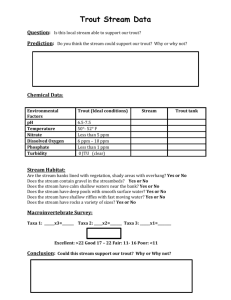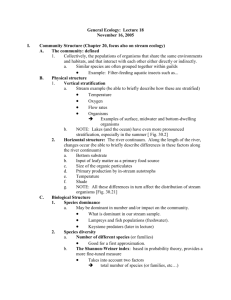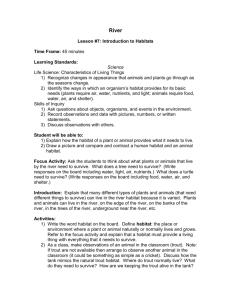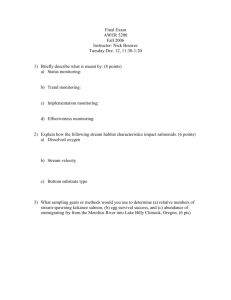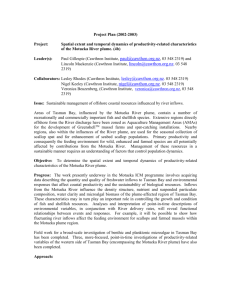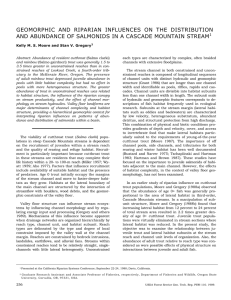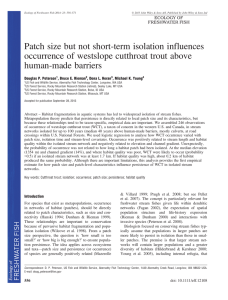Developing data and models for assessments of stream ecosystem
advertisement
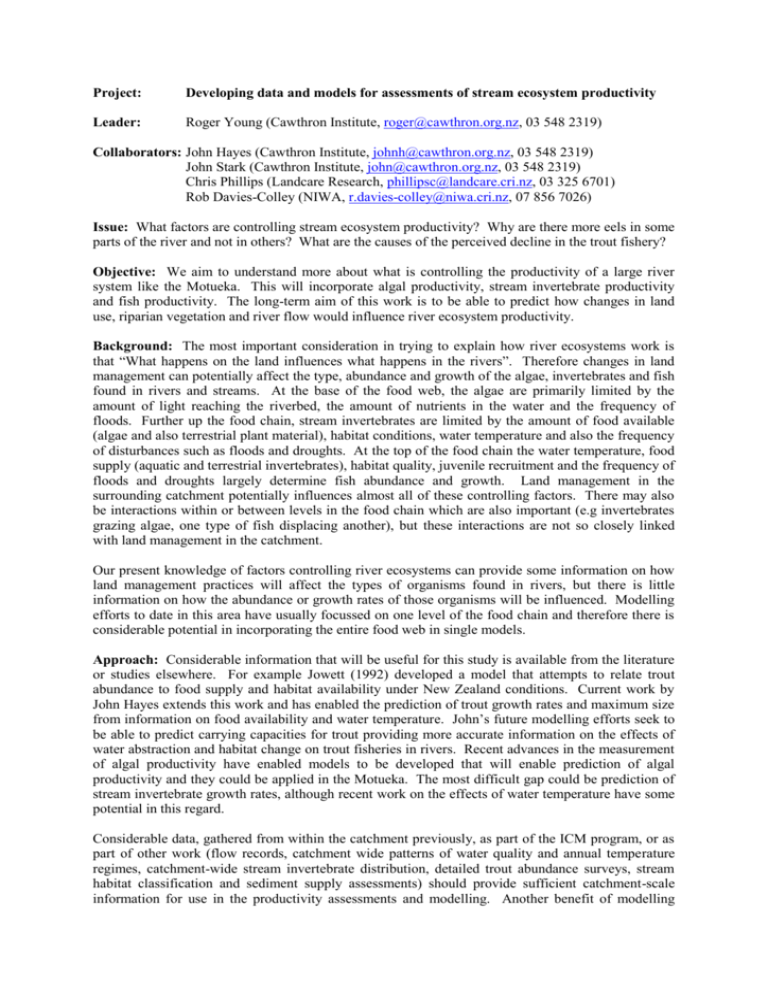
Project: Developing data and models for assessments of stream ecosystem productivity Leader: Roger Young (Cawthron Institute, roger@cawthron.org.nz, 03 548 2319) Collaborators: John Hayes (Cawthron Institute, johnh@cawthron.org.nz, 03 548 2319) John Stark (Cawthron Institute, john@cawthron.org.nz, 03 548 2319) Chris Phillips (Landcare Research, phillipsc@landcare.cri.nz, 03 325 6701) Rob Davies-Colley (NIWA, r.davies-colley@niwa.cri.nz, 07 856 7026) Issue: What factors are controlling stream ecosystem productivity? Why are there more eels in some parts of the river and not in others? What are the causes of the perceived decline in the trout fishery? Objective: We aim to understand more about what is controlling the productivity of a large river system like the Motueka. This will incorporate algal productivity, stream invertebrate productivity and fish productivity. The long-term aim of this work is to be able to predict how changes in land use, riparian vegetation and river flow would influence river ecosystem productivity. Background: The most important consideration in trying to explain how river ecosystems work is that “What happens on the land influences what happens in the rivers”. Therefore changes in land management can potentially affect the type, abundance and growth of the algae, invertebrates and fish found in rivers and streams. At the base of the food web, the algae are primarily limited by the amount of light reaching the riverbed, the amount of nutrients in the water and the frequency of floods. Further up the food chain, stream invertebrates are limited by the amount of food available (algae and also terrestrial plant material), habitat conditions, water temperature and also the frequency of disturbances such as floods and droughts. At the top of the food chain the water temperature, food supply (aquatic and terrestrial invertebrates), habitat quality, juvenile recruitment and the frequency of floods and droughts largely determine fish abundance and growth. Land management in the surrounding catchment potentially influences almost all of these controlling factors. There may also be interactions within or between levels in the food chain which are also important (e.g invertebrates grazing algae, one type of fish displacing another), but these interactions are not so closely linked with land management in the catchment. Our present knowledge of factors controlling river ecosystems can provide some information on how land management practices will affect the types of organisms found in rivers, but there is little information on how the abundance or growth rates of those organisms will be influenced. Modelling efforts to date in this area have usually focussed on one level of the food chain and therefore there is considerable potential in incorporating the entire food web in single models. Approach: Considerable information that will be useful for this study is available from the literature or studies elsewhere. For example Jowett (1992) developed a model that attempts to relate trout abundance to food supply and habitat availability under New Zealand conditions. Current work by John Hayes extends this work and has enabled the prediction of trout growth rates and maximum size from information on food availability and water temperature. John’s future modelling efforts seek to be able to predict carrying capacities for trout providing more accurate information on the effects of water abstraction and habitat change on trout fisheries in rivers. Recent advances in the measurement of algal productivity have enabled models to be developed that will enable prediction of algal productivity and they could be applied in the Motueka. The most difficult gap could be prediction of stream invertebrate growth rates, although recent work on the effects of water temperature have some potential in this regard. Considerable data, gathered from within the catchment previously, as part of the ICM program, or as part of other work (flow records, catchment wide patterns of water quality and annual temperature regimes, catchment-wide stream invertebrate distribution, detailed trout abundance surveys, stream habitat classification and sediment supply assessments) should provide sufficient catchment-scale information for use in the productivity assessments and modelling. Another benefit of modelling efforts is that it often focusses attention on the pieces of the puzzle where little information is available. Several issues have been raised by stakeholders in relation to the productivity of the river ecosystem. These include the effects of drought, water abstraction and low flows on fisheries, and the impact of sediment on habitat quality. Modelling and assessments will initially focus on these issues. Outputs & Outcomes: An assessment of the factors that are limiting fish abundance and growth and understanding of the effects of various land management options will be highly relevant to a variety of interest groups including Fish & Game, Federated Farmers, eel fisherman, iwi, forestry companies, DOC and the Tasman District Council. A range of outputs could be produced for these endusers of the research, including BMP manuals, reports and articles on the web or in suitable magazines.


